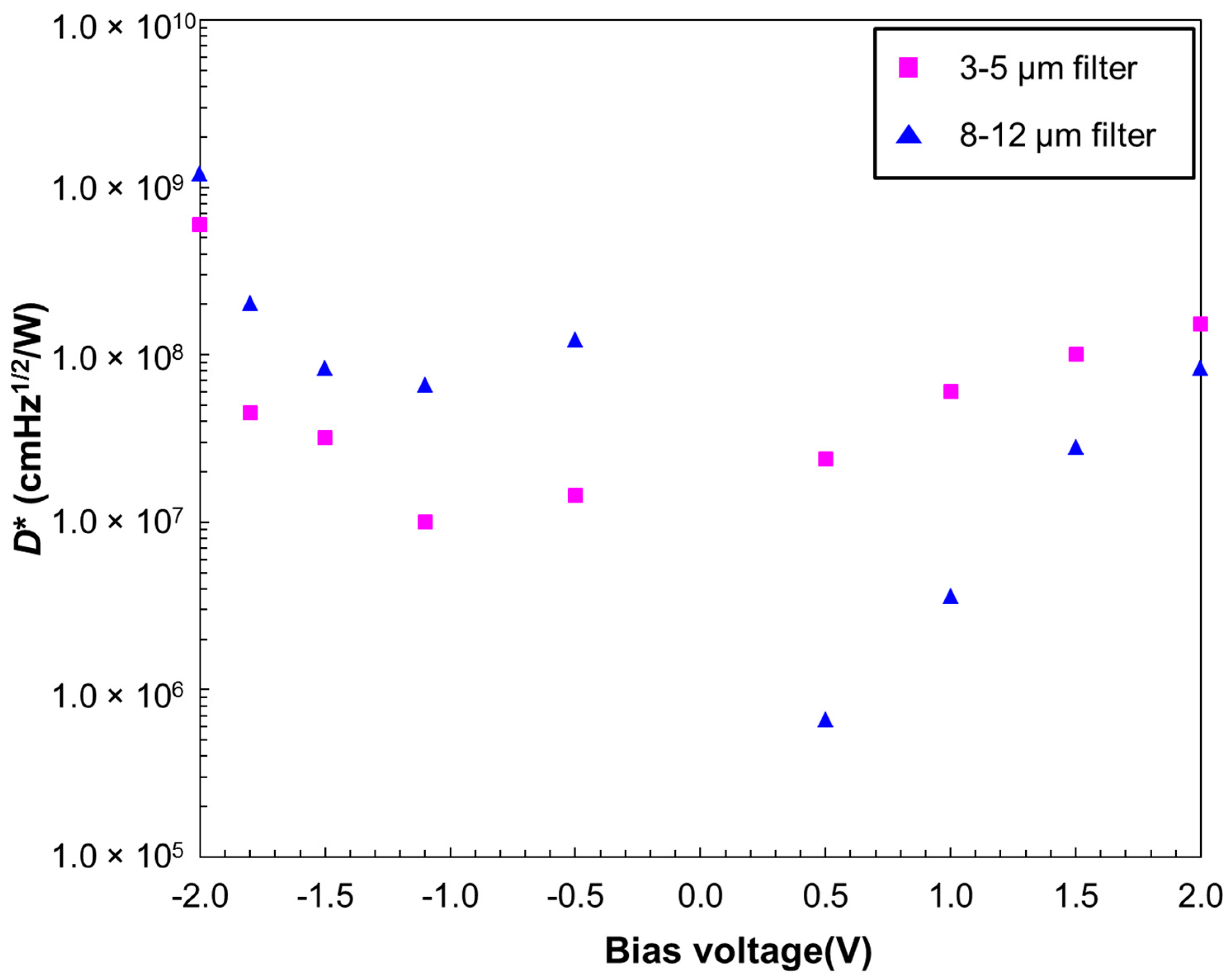Voltage-Tunable Mid- and Long-Wavelength Dual-Band Infrared Photodetector Based on Hybrid Self-Assembled and Sub-Monolayer Quantum Dots
Abstract
:1. Introduction
2. Device Structure
3. Material Growth and Device Fabrication Process
4. Device Measurement and Characterization
5. Conclusions
Author Contributions
Acknowledgments
Conflicts of Interest
References
- Ballingall, R.A. Review of infrared focal plane arrays. Infrared Technol. Appl. 1990, 1320, 70–87. [Google Scholar]
- Levine, B.F. Quantum-well infrared photodetectors. J. Appl. Phys. 1993, 74, 1–81. [Google Scholar] [CrossRef]
- Norton, P. HgCdTe infrared detectors. Opto-Electron. Rev. 2002, 10, 159–174. [Google Scholar]
- Wang, J.; Cheng, Z.; Chen, Z.; Xu, J.-B.; Tsang, H.K.; Shu, C. Graphene photodetector integrated on silicon nitride waveguide. J. Appl. Phys. 2015, 117, 144504. [Google Scholar] [CrossRef]
- Pan, D.; Towe, E.; Kennerly, S. Normal-incidence intersubband (In, Ga)As/GaAs quantum dot infrared photodetectors. Appl. Phys. Lett. 1998, 73, 1937–1939. [Google Scholar] [CrossRef]
- Vaillancourt, J.; Stintz, A.; Meisner, M.J.; Lu, X. Low-bias, high-temperature operation of an InAs–InGaAs quantum-dot infrared photodetector with peak-detection wavelength of 11.7 μm. Infrared Phys. Technol. 2009, 52, 22–24. [Google Scholar] [CrossRef]
- Lu, X.; Vaillancourt, J.; Meisner, M.J. Temperature-dependent photoresponsivity and high-temperature (190 K) operation of a quantum dot infrared photodetector. Appl. Phys. Lett. 2007, 91, 051115. [Google Scholar] [CrossRef]
- Stiff, A.D.; Krishna, S.; Bhattacharya, P.; Kennerly, S. High-detectivity, normal-incidence, mid-infrared (λ~4 μm)InAs/GaAs quantum-dot detector operating at 150 K. Appl. Phys. Lett. 2001, 79, 421–423. [Google Scholar] [CrossRef]
- Vaillancourt, J.; Vasinajindakaw, P.; Hong, W.; Lu, X.; Qian, X.; Vangala, S.R.; Goodhue, W.D. A LWIR quantum dot infrared photodetector working at 298K. In Proceedings of the SPIE OPTO, San Francisco, CA, USA, 21–25 February 2010; pp. 760821–760826. [Google Scholar]
- Ye, Z.; Campbell, J.C.; Chen, Z.; Kim, E.-T.; Madhukar, A. Voltage-controllable multiwavelength InAs quantum-dot infrared photodetectors for mid- and far-infrared detection. J. Appl. Phys. 2002, 92, 4141–4143. [Google Scholar] [CrossRef]
- Kim, J.O.; Sengupta, S.; Sharma, Y.; Barve, A.V.; Lee, S.J.; Noh, S.K.; Krishna, S. Sub-monolayer InAs/InGaAs quantum dot infrared photodetectors (SML-QDIP). In Proceedings of the SPIE Defense, Security, and Sensing, Baltimore, MD, USA, 23–27 April 2012; p. 835336. [Google Scholar]
- Meisner, M.J.; Vaillancourt, J.; Lu, X. Voltage-tunable dual-band InAs quantum-dot infrared photodetectors based on InAs quantum dots with different capping layers. Semicond. Sci. Technol. 2008, 23, 095016. [Google Scholar] [CrossRef]
- Huang, J.; Ma, W.; Wei, Y.; Zhang, Y.; Huo, Y.; Cui, K.; Chen, L. Two-color In 0.4 Ga 0.6 As/Al 0.1 Ga 0.9 As quantum dot infrared photodetector with double tunneling barriers. Appl. Phys. Lett. 2011, 98, 103501. [Google Scholar] [CrossRef]
- Krestnikov, I.L.; Ledentsov, N.N.; Hoffmann, A.; Bimberg, D. Arrays of Two-Dimensional Islands Formed by Submonolayer Insertions: Growth, Properties, Devices. Phys. Status Solidi A 2001, 183, 207–233. [Google Scholar] [CrossRef]
- Xu, Z.; Birkedal, D.; Hvam, J.M.; Zhao, Z.; Liu, Y.; Yang, K.; Kanjilal, A.; Sadowski, J. Structure and optical anisotropy of vertically correlated submonolayer InAs/GaAs quantum dots. Appl. Phys. Lett. 2003, 82, 3859–3861. [Google Scholar] [CrossRef]
- Hopfer, F.; Mutig, A.; Kuntz, M.; Fiol, G.; Bimberg, D.; Ledentsov, N.N.; Shchukin, V.A.; Mikhrin, S.S.; Livshits, D.L.; Krestnikov, I.L.; et al. Single-mode submonolayer quantum-dot vertical-cavity surface-emitting lasers with high modulation bandwidth. Appl. Phys. Lett. 2006, 89, 141106. [Google Scholar] [CrossRef]
- Ting, D.Z.-Y.; Bandara, S.V.; Gunapala, S.D.; Mumolo, J.M.; Keo, S.A.; Hill, C.J.; Liu, J.K.; Blazejewski, E.R.; Rafol, S.B.; Chang, Y.-C. Submonolayer quantum dot infrared photodetector. Appl. Phys. Lett. 2009, 94, 111107. [Google Scholar] [CrossRef] [Green Version]
- Ning, L.; Peng, J.; Zhan-Guo, W. Broadband light emitting from multilayer-stacked InAs/GaAs quantum dots. Chin. Phys. B 2012, 21, 117305. [Google Scholar]
- Perera, A.; Ariyawansa, G.; Huang, G.; Bhattacharya, P. Quantum dot nanostructures for multi-band infrared detection. Infrared Phys. Technol. 2009, 52, 252–256. [Google Scholar] [CrossRef]








© 2018 by the authors. Licensee MDPI, Basel, Switzerland. This article is an open access article distributed under the terms and conditions of the Creative Commons Attribution (CC BY) license (http://creativecommons.org/licenses/by/4.0/).
Share and Cite
Zhai, Y.; Gu, G.; Lu, X. Voltage-Tunable Mid- and Long-Wavelength Dual-Band Infrared Photodetector Based on Hybrid Self-Assembled and Sub-Monolayer Quantum Dots. Micromachines 2019, 10, 4. https://doi.org/10.3390/mi10010004
Zhai Y, Gu G, Lu X. Voltage-Tunable Mid- and Long-Wavelength Dual-Band Infrared Photodetector Based on Hybrid Self-Assembled and Sub-Monolayer Quantum Dots. Micromachines. 2019; 10(1):4. https://doi.org/10.3390/mi10010004
Chicago/Turabian StyleZhai, Yao, Guiru Gu, and Xuejun Lu. 2019. "Voltage-Tunable Mid- and Long-Wavelength Dual-Band Infrared Photodetector Based on Hybrid Self-Assembled and Sub-Monolayer Quantum Dots" Micromachines 10, no. 1: 4. https://doi.org/10.3390/mi10010004
APA StyleZhai, Y., Gu, G., & Lu, X. (2019). Voltage-Tunable Mid- and Long-Wavelength Dual-Band Infrared Photodetector Based on Hybrid Self-Assembled and Sub-Monolayer Quantum Dots. Micromachines, 10(1), 4. https://doi.org/10.3390/mi10010004




